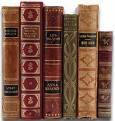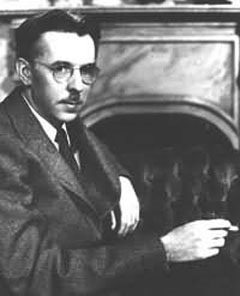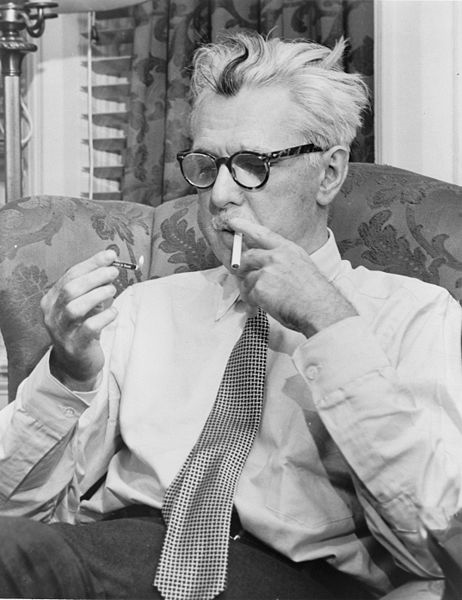                                            |
|
JAMES THURBER
(1894-1961) |

 |
BACKGROUND
- Columbus, Ohio
- father = Charles Leander/Lincoln,
politician
- mother = Mary Fisher
- 1919:
- 1918-25:
- code clerk for Dept. of State
- in Washington, DC
- & American Embassy, Paris
- (couldn't join Army b/c eyes)
- blindness
-
lost an eye in a childhood accident
-
playing William Tell with his brother
-
later developed a progressive condition in his remaining eye
-
that eventually robbed him of all sight
- STILL wrote,
drew, illustrated!
|
BACKGROUND
- 1921-24:
- humorist, cartoonist, illustrator, and playwright
- at Columbus Dispatch
- 1925-26:
- reporter for Paris edition at Chicago Tribune
- 1926:
- reporter for New York Evening Post
- 1927:
- managing editor for New Yorker
- 1927-33:
- staff writer, chiefly for "Talk of the Town" column
- for New Yorker
- 1933-61:
- regular contributor for New Yorker
- art exhibits:
- several one-man shows
- 1933: shows at the Valentine Gallery, New York
City
- 1937: at the Storran Gallery, London
 |
 |

 |
THEMES
- humor
- desperation in modern world
- underlying tension, desperation
- conflict between Man & Society (technology)
|
THEMES
- BOOKS:
- Steppenwolf (1929)
- The Owl in the Attic and Other Perplexities
(1931)
- The Seal in the Bedroom and Other Predicaments
(1932)
- My Life and Hard Times (1933, memoir)
- The Middle-Aged Man on the Flying Trapeze (1935)
- Let Your Mind Alone! (1937)
- The Last Flower (1939)
- Men, Women and Dogs (1943)
- The Great Quillow (1944, juvenile)
- The White Deer (1945)
- The Thurber Carnival (1945)
- The Beast in Me and Other Animals (1948)
- Thirteen Clocks
- Thurber Country (1953)
- Thurber on Humor (1953)
- Thurber's Dogs (1955)
- A Thurber Garland (1955)
- Further Fables For Our Time (1956)
- Alarms and Diversions (1957)
- The Wonderful O (1957)
- The Years With Ross (1959, biography)
- Harold Ross, editor of New Yorker
- Credos and Curios (1962)
- Thurber & Company (1966)
|
 |

 |
STYLE
- not so funny
- underlying tension
- Thurber: "I'm always astounded when my humor is
described as gentle...It's anything but that."
- EB White: "a
strong undercurrent of grief"
- "An underlying tension, a desperation, is present
in Thurber's work
- Charles S. Holmes, in his Thurber: A Collection of
Critical Essays, noted that "the pessimism and the
sense of disaster which give Thurber's world its special
atmosphere"
- and in his The Art of James Thurber, Richard C.
Tobias suggested that he made "laughter possible for
us by deliberately choosing subjects that will create
nervous, unsettling and unbearable tensions."
- Speaking of himself and other "writers of light pieces"
in his foreword to My Life and Hard Times, Thurber
pointed out that "the notion that such persons are gay
of heart and carefree is curiously untrue.... To call such
persons `humorists,' a loose-fitting and ugly word, is to
miss the nature of their dilemma and the dilemma of their
nature. The little wheels of their invention are set in
motion by the damp hand of melancholy."
- According to John Updike in Thurber: A Collection of
Critical Essays, "Thurber's genius was to make of our
despair a humorous fable."
- qtd. from CA
- GENRES:
- essays
- stories
- novels
- plays
- fables
- children's fiction
- cartoons
- illustrator
- artwork
- biography
- satire/parody
- Is Sex Necessary?
- Let Your Mind Alone
- influence of EB White
- friend at the New Yorker
- alter his style from journalism to fiction writing
3 periods of his writing career:
- (1) 1929-1937
- "develops the comedy of the little man menaced by
civilization"
- The books of Thurber's first period, collections of
short pieces and drawings first published in the New
Yorker, are generally considered to contain most of his
best work.
- (2) 1937-1950
- The second period is a time of exploration for Thurber,
when he published fables like The Last Flower: A Parable
in Pictures and Fables for Our Time and Famous Poems
Illustrated, had his play The Male Animal
successfully produced, and wrote the first of his children's
books.
- despite going blind (several operations on his "good"
eye)
- (3) 1950s
- Thurber returned to the subject matter of his early work
but with a deeper understanding
- Many later titles reprint pieces from early books,
sometimes including other Thurber material not previously
reprinted from the New Yorker.
|
STYLE
-
domestic comedy:
-
stories based on middle-class domestic situations
- based on
tumultuous 1st marriage
-
based on actual events in his life
- conflict
between men & women
- "battle of
the sexes"
- MEN
=
- timid
- befuddled
- by strong,
competent, resourceful women
- by modern
technologies
- EB White:
"frustrated, fugitive beings"
- WOMEN
=
- SOCIETY
=
- modern world
- dangerously
precarious nature
- of everyday
life
- humor
-
"one of the world's greatest humorists" Alistair
Cooke
- domestic comedy
- bizarre
- hope in humor
- Thurber's "played down"
style
- his word
- economical, lean, & conversational
- calm and precise
- perhaps to counter-balance his bizarre humor
- a dry sense of humor
- "comedy is heightened by the contrast between
the unexcitable delivery and the frenetic events
described"
- unobtrusive
- "It is a style which does its best not to call
attention to itself through any deviations from the
norm."
- "a fastidious stylist
- with psychological depth, subtlety and complexity;
- with a keen sense of pace, tone, ease, and climax;
- and with imagination that often wandered into
surrealism."
-
EB White: "the fierce sweep, the economy, and
the magnificent obscurity of Thurber's work.... All I,
all anybody, can do is to hint at the uncanny
faithfulness with which he has caught--caught and thrown
to the floor--the daily, indeed the almost momently,
severity of life's mystery, as well as the charming
doubtfulness of its purpose."
-
realistic:
- real people
- real
situations
- real
feelings, frustrations
- real life
- "The Secret Life of Walter
Mitty"
- Included in My World--and Welcome to It is one of
Thurber's most famous short stories, "The Secret Life of
Walter Mitty."
- The story concerns a man who daydreams heroic adventures
to escape from a domineering wife and a boring job.
- "The story is a masterpiece of associational
psychology," wrote Hasley, "in its shuttling between the
petty, humiliating details of his outer life and the flaming
heroism of his self-glorifying reveries."
- In this story, according to Carl M. Lindner in the
Georgia Review, Thurber "touched upon one of the major
themes in American literature--the conflict between
individual and society."
|
 |
LINKS
 LINKS
LINKS
|























































































